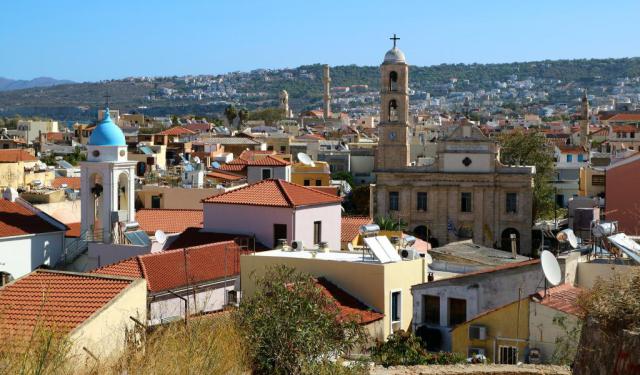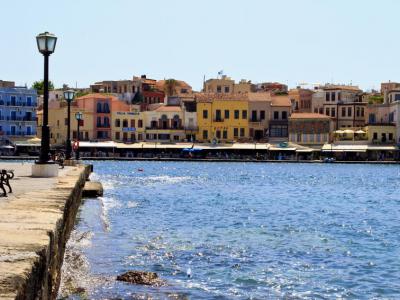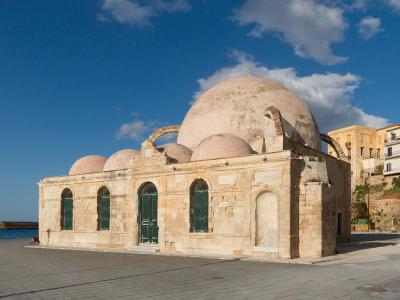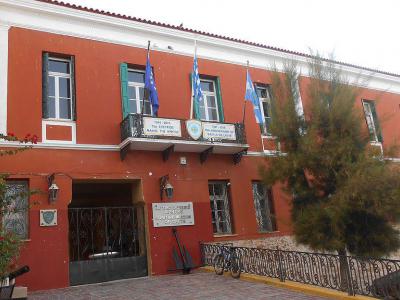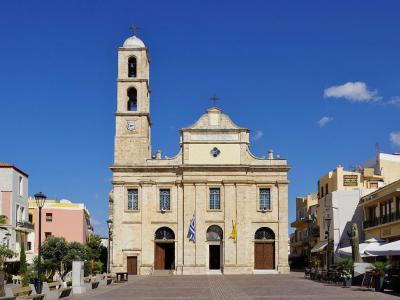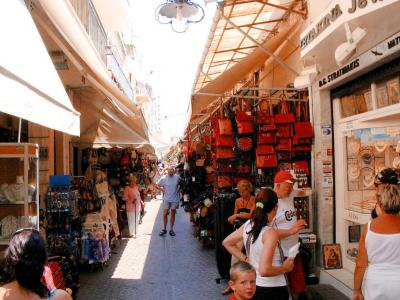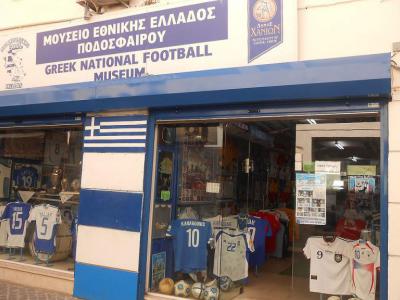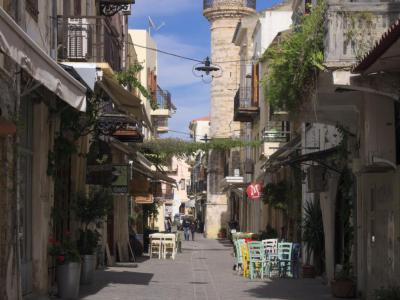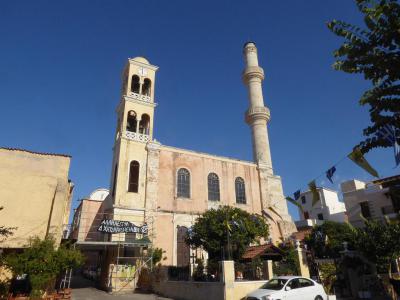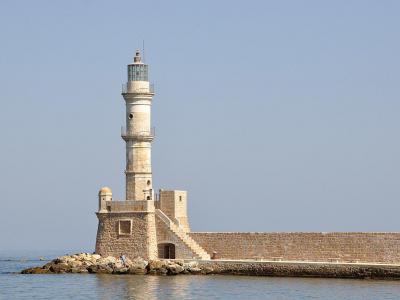Audio Guide: Chania Introduction Walking Tour (Self Guided), Chania
Nineteenth-century English traveler Robert Pashley swore Chania “will repay the traveler a hundredfold.” The story of Chania stretches deep into antiquity. Its earliest name, Kydonia, appears in the epic works of Greek poet Homer and is thought to derive from the quince fruit that once grew in abundance here. Archaeological evidence shows that as early as the 14th century BC, the Minoans built a significant settlement on this site-part of their wider Bronze Age civilization that flourished across Crete. After the decline of the Minoans, the Dorians arrived around 1100 BC, establishing their own presence.
In the centuries that followed, the city prospered under classical Greek influence before becoming part of the Roman Empire in the 1st century BC. The city’s Roman villas and mosaics still testify to the prosperity of this era. By the 4th century AD, Chania entered the Byzantine sphere, with its fortifications strengthened to withstand repeated Arab raids that swept across the Aegean in the 8th and 9th centuries.
A new chapter began in 1252, when the Venetians secured Crete and reshaped Chania into a thriving commercial hub. For nearly four centuries, from the 13th to the 17th, they expanded the harbor, built the long line of stone arsenals to house their fleets, and left behind elegant palaces and churches. The Chania Lighthouse, added between 1570 and 1590, became both a beacon for sailors and a symbol of Venetian prestige. In 1645, after a long and bloody siege, the Ottomans captured Chania, altering the skyline once again with mosques, bathhouses, and minarets-while leaving the Venetian foundations largely intact.
Modern history brought further transformation. In 1913, Crete formally united with Greece, with Chania briefly becoming the island’s capital.
Walking through downtown Chania today, visitors encounter a captivating blend of Venetian, Ottoman, and Greek influences. The Old Venetian Harbor dazzles with its lighthouse, colorful buildings, and waterfront cafés. Narrow cobblestone streets wind through the Old Town, lined with boutique shops, historic churches, and traditional tavernas. Highlights include the Nautical Museum, the Grand Arsenal, and the vibrant Leather Street.
Today, Pashley’s words ring true: Chania more than repays the travelers who visit the city-it rewards them richly, at every turn.
In the centuries that followed, the city prospered under classical Greek influence before becoming part of the Roman Empire in the 1st century BC. The city’s Roman villas and mosaics still testify to the prosperity of this era. By the 4th century AD, Chania entered the Byzantine sphere, with its fortifications strengthened to withstand repeated Arab raids that swept across the Aegean in the 8th and 9th centuries.
A new chapter began in 1252, when the Venetians secured Crete and reshaped Chania into a thriving commercial hub. For nearly four centuries, from the 13th to the 17th, they expanded the harbor, built the long line of stone arsenals to house their fleets, and left behind elegant palaces and churches. The Chania Lighthouse, added between 1570 and 1590, became both a beacon for sailors and a symbol of Venetian prestige. In 1645, after a long and bloody siege, the Ottomans captured Chania, altering the skyline once again with mosques, bathhouses, and minarets-while leaving the Venetian foundations largely intact.
Modern history brought further transformation. In 1913, Crete formally united with Greece, with Chania briefly becoming the island’s capital.
Walking through downtown Chania today, visitors encounter a captivating blend of Venetian, Ottoman, and Greek influences. The Old Venetian Harbor dazzles with its lighthouse, colorful buildings, and waterfront cafés. Narrow cobblestone streets wind through the Old Town, lined with boutique shops, historic churches, and traditional tavernas. Highlights include the Nautical Museum, the Grand Arsenal, and the vibrant Leather Street.
Today, Pashley’s words ring true: Chania more than repays the travelers who visit the city-it rewards them richly, at every turn.
How it works: Download the app "GPSmyCity: Walks in 1K+ Cities" from Apple App Store or Google Play Store to your mobile phone or tablet. The app turns your mobile device into a personal tour guide and its built-in GPS navigation functions guide you from one tour stop to next. The app works offline, so no data plan is needed when traveling abroad.
Chania Introduction Walking Tour Map
Guide Name: Chania Introduction Walking Tour
Guide Location: Greece » Chania (See other walking tours in Chania)
Guide Type: Self-guided Walking Tour (Sightseeing)
# of Attractions: 11
Tour Duration: 2 Hour(s)
Travel Distance: 3.2 Km or 2 Miles
Author: DanaOffice
Sight(s) Featured in This Guide:
Guide Location: Greece » Chania (See other walking tours in Chania)
Guide Type: Self-guided Walking Tour (Sightseeing)
# of Attractions: 11
Tour Duration: 2 Hour(s)
Travel Distance: 3.2 Km or 2 Miles
Author: DanaOffice
Sight(s) Featured in This Guide:
- Old Venetian Harbor
- Kucuk Hasan Pasha Mosque
- Nautical Museum of Crete
- Assumption Cathedral
- Skridlof Street (Leather Street)
- Greek National Football Museum
- Chatzimichali Ntaliani Street
- Church of Saint Nicholas
- Church of Saint Rocco
- Grand Arsenal
- Chania Lighthouse
1) Old Venetian Harbor (must see)
Long before Venetian galleys filled the bay, this stretch of Crete’s north coast sheltered the Minoans of Kydonia, who traded here as early as the 14th century BC. By the time the Venetians arrived in 1320, they saw not just a natural inlet but a jewel worth fortifying. Over the next three centuries, they poured stone and sweat into creating one of the strongest ports in the eastern Mediterranean. The harbor became both a marketplace and a fortress, where merchants unloaded cloth and spices under the shadow of warships waiting in the basins.
The eastern side rang with the sound of shipbuilding inside the great arsenals. Seventeen vast halls rose between 1467 and 1599, their arched openings facing the sea so galleys could be hauled inside for repair. In 1607, three more-called the Moro Docks-were added, just as the Republic of Venice prepared for renewed conflict with the Ottomans. Sailors’ songs and hammer strikes once filled those halls, a contrast to the art exhibitions they house today.
At the harbor’s mouth, a lighthouse was added between 1570 and 1590, its flame guiding ships returning from Venice or Alexandria. In 1645, during the Ottoman siege of Chania, it stood as a witness to weeks of bombardment that reduced much of the city to rubble. When the Ottomans triumphed, they raised mosques and hammams around the waterfront, leaving their own imprint on the Venetian skeleton. The lighthouse itself would later be rebuilt by the Egyptians in the 19th century, giving it the curious blend of Venetian bones and Ottoman-Egyptian dress that survives today.
Every corner of the harbor carries such stories: the Firkas Fortress, where the Venetian banner once flew, now holds a Nautical Museum with a replica Minoan ship; the Yali Tzamii Mosque recalls centuries of Ottoman prayer; and the café-lined promenade still hums with conversation much like it did when sailors struck bargains over wine. Walk the mole to the lighthouse at sunset, and the layers of history fall into place-the Minoan traders, the Venetian shipwrights, the Ottoman conquerors-all bound to this same stretch of sea.
The eastern side rang with the sound of shipbuilding inside the great arsenals. Seventeen vast halls rose between 1467 and 1599, their arched openings facing the sea so galleys could be hauled inside for repair. In 1607, three more-called the Moro Docks-were added, just as the Republic of Venice prepared for renewed conflict with the Ottomans. Sailors’ songs and hammer strikes once filled those halls, a contrast to the art exhibitions they house today.
At the harbor’s mouth, a lighthouse was added between 1570 and 1590, its flame guiding ships returning from Venice or Alexandria. In 1645, during the Ottoman siege of Chania, it stood as a witness to weeks of bombardment that reduced much of the city to rubble. When the Ottomans triumphed, they raised mosques and hammams around the waterfront, leaving their own imprint on the Venetian skeleton. The lighthouse itself would later be rebuilt by the Egyptians in the 19th century, giving it the curious blend of Venetian bones and Ottoman-Egyptian dress that survives today.
Every corner of the harbor carries such stories: the Firkas Fortress, where the Venetian banner once flew, now holds a Nautical Museum with a replica Minoan ship; the Yali Tzamii Mosque recalls centuries of Ottoman prayer; and the café-lined promenade still hums with conversation much like it did when sailors struck bargains over wine. Walk the mole to the lighthouse at sunset, and the layers of history fall into place-the Minoan traders, the Venetian shipwrights, the Ottoman conquerors-all bound to this same stretch of sea.
2) Kucuk Hasan Pasha Mosque
When the Ottomans captured Chania in 1645 after a long and brutal siege, they wasted no time in remaking the city’s face. Among the most visible changes was the construction of a new mosque right on the Venetian Harbor, completed in 1649 and dedicated to their first governor, Küçük Hasan Pasha-“Little Hasan,” whose name survives in the building to this day. Unlike the many churches that were converted into mosques after the conquest, this one was raised from scratch, a bold gesture that placed Ottoman faith and authority at the very center of Chania’s daily life.
For nearly three centuries its dome sheltered the prayers of the city’s Muslim community. Contemporary travelers described how the sea breeze swept through the arched porticoes, while the tall minaret-lost in 1939-once pierced the skyline. The main dome, supported by four graceful arches, was originally flanked by six smaller ones, creating a rhythm that echoed across the harbor. Through earthquakes and bombardments, the mosque endured, its pale stone softening and brightening with each shift of light.
The tides of history eventually caught up with it. Following the Greco-Turkish War and the 1923 population exchange, the mosque fell silent. No longer used for worship, it drifted through new roles: a warehouse, a folk museum, even a tourist office. Yet this reinvention kept it alive, turning it into a vessel of memory rather than a ruin.
Today, Küçük Hasan Pasha Mosque, or Yiali Tzamii, often hosts art exhibitions and cultural events. Its domed outline against the sea is one of the most photographed images of Chania-less a monument to conquest now than a reminder of the city’s resilience, where layers of faith and empire converge in one enduring landmark.
For nearly three centuries its dome sheltered the prayers of the city’s Muslim community. Contemporary travelers described how the sea breeze swept through the arched porticoes, while the tall minaret-lost in 1939-once pierced the skyline. The main dome, supported by four graceful arches, was originally flanked by six smaller ones, creating a rhythm that echoed across the harbor. Through earthquakes and bombardments, the mosque endured, its pale stone softening and brightening with each shift of light.
The tides of history eventually caught up with it. Following the Greco-Turkish War and the 1923 population exchange, the mosque fell silent. No longer used for worship, it drifted through new roles: a warehouse, a folk museum, even a tourist office. Yet this reinvention kept it alive, turning it into a vessel of memory rather than a ruin.
Today, Küçük Hasan Pasha Mosque, or Yiali Tzamii, often hosts art exhibitions and cultural events. Its domed outline against the sea is one of the most photographed images of Chania-less a monument to conquest now than a reminder of the city’s resilience, where layers of faith and empire converge in one enduring landmark.
3) Nautical Museum of Crete (must see)
The Nautical Museum of Crete, also called the Maritime Museum, was founded in 1973 on the anniversary of the Battle of Crete, a date chosen deliberately to tie modern memory to centuries of maritime struggle. Its home, the red-walled Firkas Fortress at the western entrance to Chania’s Venetian Harbor, carries layers of symbolism. Built by the Venetians in 1620 to guard the harbor, it was later used by the Ottomans-its very name “Firkas” means “barracks” in Turkish-and in 1913 it became the site where the Greek flag was first raised to mark Crete’s union with Greece. Cannons once aimed through its arched embrasures and chains stretched to the lighthouse across the mole remind visitors that this harbor was never merely picturesque-it was a frontline of power.
Inside the fortress, the museum is laid out as a journey through time. The lower floors move from antiquity through the Venetian and Ottoman eras, with ship models, navigational instruments, and artifacts recovered from the seabed. A model of Venetian Chania depicts the arsenals in full use, while a highlight is the replica of a Minoan ship, reconstructed using Bronze Age techniques, which recalls the daring seamanship of Crete’s earliest sailors. Upstairs, the focus shifts to modern naval history, with models of destroyers, frigates, and even a full bridge of a Greek navy destroyer. Exhibits tell of the Greek War of Independence, the Balkan Wars, and the dramatic role of the navy in the 1941 Battle of Crete.
The museum’s reach extends to the Moro Shipyard on the harbor’s eastern end, where a 56-foot Minoan ship replica, built in 2001–2004, is displayed after sailing from Piraeus to Crete. Beyond the artifacts, what lingers is the human dimension-photographs, uniforms, and testimonies that link strategy to lived experience. For visitors, the Nautical Museum offers more than models behind glass. It connects the fortress walls, the harbor waters outside, and the centuries of conflict, trade, and survival that shaped Chania into the maritime city it remains today.
Inside the fortress, the museum is laid out as a journey through time. The lower floors move from antiquity through the Venetian and Ottoman eras, with ship models, navigational instruments, and artifacts recovered from the seabed. A model of Venetian Chania depicts the arsenals in full use, while a highlight is the replica of a Minoan ship, reconstructed using Bronze Age techniques, which recalls the daring seamanship of Crete’s earliest sailors. Upstairs, the focus shifts to modern naval history, with models of destroyers, frigates, and even a full bridge of a Greek navy destroyer. Exhibits tell of the Greek War of Independence, the Balkan Wars, and the dramatic role of the navy in the 1941 Battle of Crete.
The museum’s reach extends to the Moro Shipyard on the harbor’s eastern end, where a 56-foot Minoan ship replica, built in 2001–2004, is displayed after sailing from Piraeus to Crete. Beyond the artifacts, what lingers is the human dimension-photographs, uniforms, and testimonies that link strategy to lived experience. For visitors, the Nautical Museum offers more than models behind glass. It connects the fortress walls, the harbor waters outside, and the centuries of conflict, trade, and survival that shaped Chania into the maritime city it remains today.
4) Assumption Cathedral
The Assumption Cathedral of Chania carries with it the layered story of the city itself. Long before it became the main Orthodox church of Crete’s western capital, the site belonged to a Venetian church dedicated to the Virgin Mary. When the Ottomans seized Chania in the mid-17th century, the church was stripped of its sacred role and converted into a soap factory. Local lore tells of the factory’s owner, who, after falling on hard times, vowed to return the building to the Christian community if fortune smiled on him again. In 1850, true to his promise, the site was restored to its religious use-an act that spoke to the endurance of Chania’s Christian population under foreign rule.
The present cathedral rose gradually in the decades that followed, shaped by the political changes of Crete. By 1860, it had taken on its recognizable form as a three-aisled basilica dedicated to the Assumption of the Virgin Mary, earning the local nickname “Trimartiri,” or “three martyrs.” It was consecrated as the city’s cathedral in 1874, only to face damage from earthquakes and require rebuilding. The 19th-century design combined Byzantine tradition with neoclassical influences, a reflection of the island’s desire to tie its future with Greece while still honoring its past.
Beyond its architecture, the cathedral has always been part of daily life in Chania. Ceremonies, festivals, and quiet devotions unfold inside, while outside Athinagora Square remains one of the Old Town’s busiest crossroads. To walk here is to see how faith has persisted through conquest, siege, and political change. For today’s visitors, the Assumption Cathedral is not only a monument but a living witness to Chania’s resilience, its dome and icons still anchoring the city’s spiritual heart.
The present cathedral rose gradually in the decades that followed, shaped by the political changes of Crete. By 1860, it had taken on its recognizable form as a three-aisled basilica dedicated to the Assumption of the Virgin Mary, earning the local nickname “Trimartiri,” or “three martyrs.” It was consecrated as the city’s cathedral in 1874, only to face damage from earthquakes and require rebuilding. The 19th-century design combined Byzantine tradition with neoclassical influences, a reflection of the island’s desire to tie its future with Greece while still honoring its past.
Beyond its architecture, the cathedral has always been part of daily life in Chania. Ceremonies, festivals, and quiet devotions unfold inside, while outside Athinagora Square remains one of the Old Town’s busiest crossroads. To walk here is to see how faith has persisted through conquest, siege, and political change. For today’s visitors, the Assumption Cathedral is not only a monument but a living witness to Chania’s resilience, its dome and icons still anchoring the city’s spiritual heart.
5) Skridlof Street (Leather Street)
Skridlof Street, better known as Leather Lane, is one of those places where history lingers in the air even as the present bustles around it. Tucked into the Old Town near the Municipal Market, the lane earned its reputation in the 19th century when shoemakers and bootmakers set up their workshops here. Their craft was legendary-this was the birthplace of the tall Cretan boots known as stivania, worn by shepherds roaming the White Mountains and later by rebels fighting for independence. The clatter of hammers on wooden lasts and the earthy scent of hides once filled the alley, giving it both its name and its identity.
Although the golden age of the bootmakers has long passed, echoes of it remain. Family-run shops still display traditional footwear alongside belts, bags, and sandals, some hand-made by descendants of those earlier craftsmen. Ordering a custom pair of boots, complete with the traditional wide trousers and headscarf that once accompanied them, is still possible for those who want a piece of living heritage.
Over time, the street has expanded beyond leather goods, and today its stalls and shops also sell jewelry, embroidery, and keepsakes of Crete. Yet Leather Street retains its role as a bridge between Chania’s mercantile traditions and modern life. Walking its narrow length, with shops pressing close and voices carrying down the alley, visitors glimpse how one trade once shaped a whole neighborhood and how its legacy still weaves into the city’s story.
Although the golden age of the bootmakers has long passed, echoes of it remain. Family-run shops still display traditional footwear alongside belts, bags, and sandals, some hand-made by descendants of those earlier craftsmen. Ordering a custom pair of boots, complete with the traditional wide trousers and headscarf that once accompanied them, is still possible for those who want a piece of living heritage.
Over time, the street has expanded beyond leather goods, and today its stalls and shops also sell jewelry, embroidery, and keepsakes of Crete. Yet Leather Street retains its role as a bridge between Chania’s mercantile traditions and modern life. Walking its narrow length, with shops pressing close and voices carrying down the alley, visitors glimpse how one trade once shaped a whole neighborhood and how its legacy still weaves into the city’s story.
6) Greek National Football Museum (must see)
The Greek National Football Museum in Chania hides in plain sight, behind the modest façade of what looks like another Old Town souvenir shop. Its unassuming setting only adds to the sense of discovery, for inside lies a treasure trove of stories, victories, and emotions tied to Greece’s most beloved sport. The museum exists thanks to the passion of Nikos Pantelis, a lifelong collector whose childhood hobby of gathering shirts and memorabilia grew into one of the most complete football archives in Greece. His decision to root the collection in Chania, rather than Athens or Thessaloniki, reflects both his Cretan ties and the city’s deep love for the game.
The rooms are packed with jerseys, balls, and relics that carry the weight of memory. More than 1,000 Greek shirts and hundreds of foreign ones line the displays, many donated by players and fans. Among the standout pieces is the jersey David Beckham wore when he scored a famous last-minute free kick, an item visitors can even try on. Yet the undisputed jewel is the complete set of shirts from Greece’s European Championship 2004 squad, the underdog team that stunned the continent by winning the championship. Alongside them rests the autographed match ball from the final in Lisbon, a relic that recalls one of the proudest moments in modern Greek history.
But the museum stretches beyond that single triumph. Signed jerseys of Pelé, Maradona, and Ronaldo hang as reminders of football’s global stage, while domestic relics evoke the passion of Greek derbies and qualifiers. More than statistics or tactics, the collection tells stories-of joy, heartbreak, and resilience. For visitors, stepping into the museum feels like entering football’s living memory, where Chania’s narrow streets echo with both local pride and the roar of distant stadiums.
The rooms are packed with jerseys, balls, and relics that carry the weight of memory. More than 1,000 Greek shirts and hundreds of foreign ones line the displays, many donated by players and fans. Among the standout pieces is the jersey David Beckham wore when he scored a famous last-minute free kick, an item visitors can even try on. Yet the undisputed jewel is the complete set of shirts from Greece’s European Championship 2004 squad, the underdog team that stunned the continent by winning the championship. Alongside them rests the autographed match ball from the final in Lisbon, a relic that recalls one of the proudest moments in modern Greek history.
But the museum stretches beyond that single triumph. Signed jerseys of Pelé, Maradona, and Ronaldo hang as reminders of football’s global stage, while domestic relics evoke the passion of Greek derbies and qualifiers. More than statistics or tactics, the collection tells stories-of joy, heartbreak, and resilience. For visitors, stepping into the museum feels like entering football’s living memory, where Chania’s narrow streets echo with both local pride and the roar of distant stadiums.
7) Chatzimichali Ntaliani Street
Chatzimichali Ntaliani Street-better known to locals as Daliani Street-winds through Chania’s Old Town with a character that feels both historic and alive. The name honors Hatzimichalis Dalianis, a revolutionary hero from Epirus who fought for Crete’s freedom in 1828 and died in battle. His story lingers in the background, reminding visitors that beneath the easy charm of this lane lies the memory of Crete’s long struggle for independence.
During Ottoman times, this was part of the Turkish quarter, and its past still lingers in the atmosphere. Low houses, arched doorways, and hints of Venetian and Ottoman design recall the street’s layered heritage. For generations, it was a working-class neighborhood, filled with workshops and tavernas that anchored daily life. Though it fell into decline in the early 20th century, restoration and renewed energy have transformed it into one of Chania’s most vibrant corners.
By day, the street hums softly with cafés, souvenir shops, and the slow pace of Old Town wanderers. But as evening arrives, it comes alive in full force. Taverns and mezedopoleia set tables along the narrow passage, locals and travelers mingle over food and wine, and the sound of music often drifts into the night. Adding to the atmosphere, the Minaret of Ahmet Aga rises nearby, one of the last Ottoman minarets in Chania, while the 16th-century Venetian Monastery of Karolo adds yet another layer of history.
Walking down Daliani Street today is less about monuments and more about spirit-an experience where centuries of change blend seamlessly with the lively rhythm of modern Chania.
During Ottoman times, this was part of the Turkish quarter, and its past still lingers in the atmosphere. Low houses, arched doorways, and hints of Venetian and Ottoman design recall the street’s layered heritage. For generations, it was a working-class neighborhood, filled with workshops and tavernas that anchored daily life. Though it fell into decline in the early 20th century, restoration and renewed energy have transformed it into one of Chania’s most vibrant corners.
By day, the street hums softly with cafés, souvenir shops, and the slow pace of Old Town wanderers. But as evening arrives, it comes alive in full force. Taverns and mezedopoleia set tables along the narrow passage, locals and travelers mingle over food and wine, and the sound of music often drifts into the night. Adding to the atmosphere, the Minaret of Ahmet Aga rises nearby, one of the last Ottoman minarets in Chania, while the 16th-century Venetian Monastery of Karolo adds yet another layer of history.
Walking down Daliani Street today is less about monuments and more about spirit-an experience where centuries of change blend seamlessly with the lively rhythm of modern Chania.
8) Church of Saint Nicholas
The Church of Saint Nicholas in Chania is unlike any other in Greece, a building that carries the marks of conquest, faith, and resilience all at once. Its story begins in 1320, when Dominican monks raised it as a Catholic church during the Venetian era, serving the Latin community within the fortified quarter of Splantzia. For centuries it stood as a symbol of Western Christianity on Crete, until the island’s turbulent fate took another turn.
In 1645, Chania fell to the Ottomans after a brutal siege, and the Dominicans were forced out. The church was converted into the Ibrahim Mosque, named for Sultan Ibrahim, and a towering minaret was built alongside the existing bell tower. The two structures together created a sight unique in Greece-a Christian steeple and an Islamic minaret rising side by side. Local lore still recalls the image of a dervish climbing the tower with a sword, declaring faith to the four winds as the Ottomans claimed the city.
The mosque remained central to Chania’s Muslim community until 1913, when Crete joined modern Greece. By 1918, the building was rededicated as the Orthodox Church of Saint Nicholas, patron of sailors, echoing Chania’s eternal bond with the sea. During World War II, the church was bombed in the Battle of Crete, yet it endured, later restored and reopened for worship.
Today, standing in Splantzia Square, the church is as much a symbol of coexistence as it is of conflict. Cafés and tavernas spill into the square, framing a monument that tells the story of a city shaped by Venetians, Ottomans, and Greeks. The bell tower and minaret remain side by side, reminders of how Chania’s long history continues to live in its stones.
In 1645, Chania fell to the Ottomans after a brutal siege, and the Dominicans were forced out. The church was converted into the Ibrahim Mosque, named for Sultan Ibrahim, and a towering minaret was built alongside the existing bell tower. The two structures together created a sight unique in Greece-a Christian steeple and an Islamic minaret rising side by side. Local lore still recalls the image of a dervish climbing the tower with a sword, declaring faith to the four winds as the Ottomans claimed the city.
The mosque remained central to Chania’s Muslim community until 1913, when Crete joined modern Greece. By 1918, the building was rededicated as the Orthodox Church of Saint Nicholas, patron of sailors, echoing Chania’s eternal bond with the sea. During World War II, the church was bombed in the Battle of Crete, yet it endured, later restored and reopened for worship.
Today, standing in Splantzia Square, the church is as much a symbol of coexistence as it is of conflict. Cafés and tavernas spill into the square, framing a monument that tells the story of a city shaped by Venetians, Ottomans, and Greeks. The bell tower and minaret remain side by side, reminders of how Chania’s long history continues to live in its stones.
9) Church of Saint Rocco
The Church of Saint Rocco in Chania carries with it the memory of a city living through fear and faith. Built in 1630, during the Venetian era, it was dedicated to Saint Rocco, long venerated across Europe as the protector against plague. Crete was no stranger to outbreaks of disease, and this small chapel in Splantzia Square represented both a plea for protection and a tangible sign of hope. Its modest size reflected urgency rather than grandeur, yet it became an important part of the town’s spiritual and social life.
When the Ottomans seized Chania in 1645, many churches were converted into mosques. Saint Rocco’s, however, escaped that fate, perhaps because of its association with plague relief. The building endured, and over time it adapted to new roles. Under Ottoman control, it was used as a military outpost. Later, after the establishment of the Cretan State, it even served as the city’s police station until 1925. Despite these shifts, it never lost its link to the struggles and prayers of ordinary people who once turned to Saint Rocco for help in times of crisis.
Today, restored and standing quietly in the square, the church sometimes hosts art exhibitions, turning a space once tied to fear of disease into one of creativity and reflection. Surrounded by trees and the hum of modern life, it remains a reminder of Chania’s resilience-not through power or grand design, but through the quiet endurance of faith and community.
When the Ottomans seized Chania in 1645, many churches were converted into mosques. Saint Rocco’s, however, escaped that fate, perhaps because of its association with plague relief. The building endured, and over time it adapted to new roles. Under Ottoman control, it was used as a military outpost. Later, after the establishment of the Cretan State, it even served as the city’s police station until 1925. Despite these shifts, it never lost its link to the struggles and prayers of ordinary people who once turned to Saint Rocco for help in times of crisis.
Today, restored and standing quietly in the square, the church sometimes hosts art exhibitions, turning a space once tied to fear of disease into one of creativity and reflection. Surrounded by trees and the hum of modern life, it remains a reminder of Chania’s resilience-not through power or grand design, but through the quiet endurance of faith and community.
10) Grand Arsenal
The Grand Arsenal in Chania stands as both a survivor and a storyteller of the city’s long maritime past. Built in 1600 as the final and grandest of the Venetian dockyards, it was designed during a time when Venice’s empire was under pressure from Ottoman expansion. Alongside the row of arched ship sheds that once stretched across the harbor, the Grand Arsenal distinguished itself with its imposing scale and thick stone walls, a fortress-like hall where Venetian galleys could be repaired and safeguarded. For the Venetians, Chania was not just a port but a lifeline, and the Arsenal was a symbol of their determination to hold the island.
The tides of history soon changed. In 1645, after a brutal siege, the Ottomans took Chania, and the building was stripped of its naval role. It became a military hospital, later a school, and eventually adapted to civic life under different administrations. In the 19th and early 20th centuries, it served as a Christian school, a municipal hospital, even Chania’s City Hall. Yet the building suffered again during World War II, when German bombardments left it damaged and neglected.
Its fortunes revived in the late 20th century, when a careful restoration returned the Arsenal to life. Reopened in 2002, it now houses the Center of Mediterranean Architecture, a venue for exhibitions, performances, and cultural events. Standing on the harbor, the Grand Arsenal tells of Venetian ambition, Ottoman conquest, wartime devastation, and modern rebirth. For today’s visitors, it is more than a relic-it is a living reminder of Chania’s ability to adapt, endure, and reinvent itself across the centuries.
The tides of history soon changed. In 1645, after a brutal siege, the Ottomans took Chania, and the building was stripped of its naval role. It became a military hospital, later a school, and eventually adapted to civic life under different administrations. In the 19th and early 20th centuries, it served as a Christian school, a municipal hospital, even Chania’s City Hall. Yet the building suffered again during World War II, when German bombardments left it damaged and neglected.
Its fortunes revived in the late 20th century, when a careful restoration returned the Arsenal to life. Reopened in 2002, it now houses the Center of Mediterranean Architecture, a venue for exhibitions, performances, and cultural events. Standing on the harbor, the Grand Arsenal tells of Venetian ambition, Ottoman conquest, wartime devastation, and modern rebirth. For today’s visitors, it is more than a relic-it is a living reminder of Chania’s ability to adapt, endure, and reinvent itself across the centuries.
11) Chania Lighthouse (must see)
The Lighthouse of Chania stands at the mouth of the Old Venetian Harbor, a sentinel that has seen centuries of conquest, decay, and renewal. Its story begins in the late 16th century, when the Venetians fortified the harbor as part of their defense against the advancing Ottomans. The lighthouse originally had a fortified base and was part of a system that included the Firkas Fortress on the opposite side of the harbor. A heavy chain could even be stretched across the entrance to block enemy ships, a vivid reminder of the constant threat of invasion.
Despite these efforts, the Ottoman forces seized Chania in 1645 after a brutal siege, and the once-proud Venetian lighthouse fell into neglect. For nearly two centuries, the structure crumbled, no longer serving its role as a guardian for sailors. Its revival came between 1824 and 1832, when Crete fell under Egyptian administration. Rebuilt in a minaret-like style, the lighthouse took on its distinctive shape that still captures attention today. Locals often refer to it as the “Egyptian Lighthouse,” a nod to the period when Egypt briefly held sway over Crete on behalf of the Ottoman Empire.
The lighthouse endured its share of hardships in modern times as well. Bombings during World War II and earthquakes weakened the structure, leaving it scarred but not broken. A major renovation in 2005 ensured its survival, restoring its domed tower and securing its place as one of Chania’s most iconic landmarks.
Today, the lighthouse is no longer used for navigation but remains deeply woven into the identity of the city. The long mole leading out to it has become a favorite promenade for locals and visitors alike, especially at sunset when the tower casts its silhouette across the sea. For those who walk its length, the lighthouse offers more than a view-it is a connection to Chania’s layered past, a reminder of fleets, battles, and the enduring relationship between the city and the sea.
Despite these efforts, the Ottoman forces seized Chania in 1645 after a brutal siege, and the once-proud Venetian lighthouse fell into neglect. For nearly two centuries, the structure crumbled, no longer serving its role as a guardian for sailors. Its revival came between 1824 and 1832, when Crete fell under Egyptian administration. Rebuilt in a minaret-like style, the lighthouse took on its distinctive shape that still captures attention today. Locals often refer to it as the “Egyptian Lighthouse,” a nod to the period when Egypt briefly held sway over Crete on behalf of the Ottoman Empire.
The lighthouse endured its share of hardships in modern times as well. Bombings during World War II and earthquakes weakened the structure, leaving it scarred but not broken. A major renovation in 2005 ensured its survival, restoring its domed tower and securing its place as one of Chania’s most iconic landmarks.
Today, the lighthouse is no longer used for navigation but remains deeply woven into the identity of the city. The long mole leading out to it has become a favorite promenade for locals and visitors alike, especially at sunset when the tower casts its silhouette across the sea. For those who walk its length, the lighthouse offers more than a view-it is a connection to Chania’s layered past, a reminder of fleets, battles, and the enduring relationship between the city and the sea.
The Most Popular Cities
/ view all
